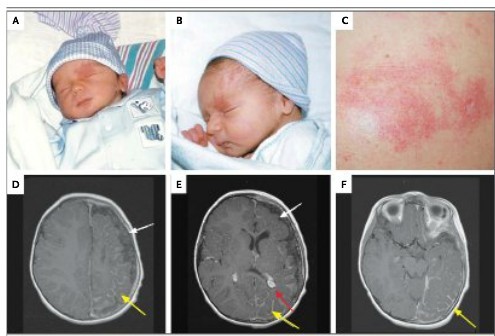NEJM:全基因组测序揭示脑面血管瘤病血管痣的突变基因
| 导读 |
脑面血管瘤病是一种罕见的先天性神经皮肤发育障碍,其临床表现包括:三叉神经眼支支配区域的红葡萄酒色状血管斑、大脑软脑膜和脉络膜静脉毛细血管异常、青光眼、癫痫发作、卒中和智力障碍。曾有假说认为体细胞嵌合突变破坏血管发育是导致脑面血管瘤病和葡萄酒色素痣的原因,其严重程度和影响范围取决于发育过程中发生突变的时间点。迄今为止,此类突变尚未被证实。该研究将... |

脑面血管瘤病是一种罕见的先天性神经皮肤发育障碍,其临床表现包括:三叉神经眼支支配区域的红葡萄酒色状血管斑、大脑软脑膜和脉络膜静脉毛细血管异常、青光眼、癫痫发作、卒中和智力障碍。曾有假说认为体细胞嵌合突变破坏血管发育是导致脑面血管瘤病和葡萄酒色素痣的原因,其严重程度和影响范围取决于发育过程中发生突变的时间点。迄今为止,此类突变尚未被证实。
该研究将3名脑面血管瘤病患者的明显受累组织和正常组织标本进行配对,分别对这些标本的DNA进行全基因组测序。使用扩增子测序和SNaPshot分析对来自50名个体(包括脑面血管瘤病患者、仅患有葡萄酒色素痣患者和健康对照者)的97个标本进行测试,检测是否存在体细胞嵌合突变,然后使用相关效应磷酸化特异性抗体和荧光素酶报告分析对这些突变进行调查,分析其对下游信号的影响。
在一些标本的GNAQ基因中检出了一种非同义单链核苷酸变异(c.548G→A, p.Arg183Gln),这些标本包括:患有脑面血管瘤病受试者的88%受累组织标本(23/26)和患有非综合征型葡萄酒色痣受试者的92%标本(12/13),而在4名与上述疾病无关的脑血管畸形受试者的受累标本和6名对照者标本中均未检出这种变异。在受累组织中中,突变等位基因的发生率为1.0%至18.1%不等。在突变体Gαq的转基因表达过程中,细胞外信号调节酶活性轻度升高。
脑面血管瘤病和葡萄酒色素痣的发病原因是发生在GNAQ基因上的体细胞激活突变,该发现证实了这一由来已久的假说。此外研究者还提出,这个突变发生在精卵结合之后,因此一般不会遗传给下一代。原文链接:
Sturge–Weber Syndrome and Port-Wine Stains Caused by Somatic Mutation in GNAQ
Background
The Sturge–Weber syndrome is a sporadic congenital neurocutaneous disorder characterized by a port-wine stain affecting the skin in the distribution of the ophthalmic branch of the trigeminal nerve, abnormal capillary venous vessels in the leptomeninges of the brain and choroid, glaucoma, seizures, stroke, and intellectual disability. It has been hypothesized that somatic mosaic mutations disrupting vascular development cause both the Sturge–Weber syndrome and port-wine stains, and the severity and extent of presentation are determined by the developmental time point at which the mutations occurred. To date, no such mutation has been identified.
Methods
We performed whole-genome sequencing of DNA from paired samples of visibly affected and normal tissue from 3 persons with the Sturge–Weber syndrome. We tested for the presence of a somatic mosaic mutation in 97 samples from 50 persons with the Sturge–Weber syndrome, a port-wine stain, or neither (controls), using amplicon sequencing and SNaPshot assays, and investigated the effects of the mutation on downstream signaling, using phosphorylation-specific antibodies for relevant effectors and a luciferase reporter assay.
Results
We identified a nonsynonymous single-nucleotide variant (c.548G→A, p.Arg183Gln) in GNAQ in samples of affected tissue from 88% of the participants (23 of 26) with the Sturge–Weber syndrome and from 92% of the participants (12 of 13) with apparently nonsyndromic port-wine stains, but not in any of the samples of affected tissue from 4 participants with an unrelated cerebrovascular malformation or in any of the samples from the 6 controls. The prevalence of the mutant allele in affected tissues ranged from 1.0 to 18.1%. Extracellular signal-regulated kinase activity was modestly increased during transgenic expression of mutant Gαq.
Conclusions
The Sturge–Weber syndrome and port-wine stains are caused by a somatic activating mutation in GNAQ. This finding confirms a long-standing hypothesis. (Funded by the National Institutes of Health and Hunter's Dream for a Cure Foundation.)

来源:丁香园
 腾讯登录
腾讯登录
还没有人评论,赶快抢个沙发